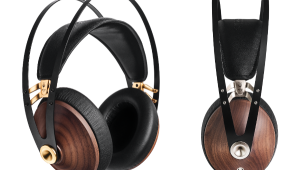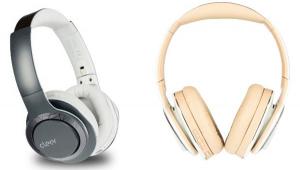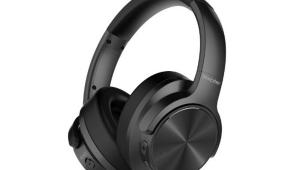I am still trying to decide. The price of the he400 seems about right for me, but the he500 is more tempting. I really like good bass so it seems the he500 is what I want.
Review: HiFiMan HE-400 and HE-500 Headphones Page 2
The panel weighs in on planar
As usual, I spent a lot of time listening to the HE-400 and HE-500 on my own, then called in some outside listeners — Morrison and L.A. voice actress Lauren Dragan — to get their opinions. For the panel tests, I used a Rane HC 6S six-output professional headphone amp to make direct comparison easy, connected to my Denon SACD/DVD/CD player and/or to the panelists’ smartphones or MP3 players. For my own listening, I used a variety of amplifiers, ranging from a Musical Fidelity V-Can to HiFiMan’s new $39 HM-101 USB headphone amp.
With the HE-400, I was able to get to a pretty reasonable volume level using my iPod touch, but the level I achieved with my Motorola Droid Pro smartphone was marginal. With the HE-500, neither portable device delivered sufficient volume. However, if you want to use either headphone on the go, you can use your smartphone in conjunction with a mini headphone amp. I found that the GoVibe Mini Box Amplifier gave me plenty of volume from my Droid with both headphones, although the bass sounded a little thin.
Geoff and I found both models comfortable, the HE-400 perhaps a little more so because of its lighter weight. In fact, for me, the HE-500 felt a bit heavy on my neck after a couple of hours, something I can’t recall experiencing with other headphones. Lauren felt that the ear pads on both were nice and soft and that the clamping force of the headband was about right, but that both models seemed to swallow her face.
Of all the headphones we’ve tested recently, the HE-400 and HE-500 got the most uniformly enthusiastic responses from our listening panel. Our reactions ranged from “like a lot” to “love,” with no major complaints. That said, the two headphones do sound substantially different.
Let’s start with the HE-400, which true to Bien’s word has a more dynamic, exciting sound. “There’s a lot of high-frequency articulation,” Lauren said. “You really hear the pluck of the guitar strings and the consonants of speech.” Geoff totally agreed. “The dynamics are fantastic,” he said. “Strings and percussion have great realism and delicacy.”
The HE-400 has a clear — but not overpowering — emphasis in the midrange, which as Lauren suggested tends to make voices sound clearer if a little exaggerated at times. There’s a nice sense of space. When I listened to the psychedelic freak-out section in the middle of Led Zeppelin’s “Whole Lotta Love,” Jimmy Page’s string scratches and Robert Plant’s wails seemed to swirl around the room and behind me. The numerous percussion instruments in “Creek (Arroio)” from Brazilian percussionist Airto’s awesome Free album (readily available on vinyl for $2 at swap meets) seemed to swarm around my head like enraged honeybees.
The bass of the HE-400 sounds tight and well-defined. “I like it, but it could go deeper,” Geoff noted. Bass freaks won’t hate this headphone, but they won’t like it either — although a bass freak wouldn’t consider an open-backed headphone in the first place, so who cares? For my taste it was just about right; this is one audiophile headphone that sounds just fine with heavy rock, although it does have more distortion at high volumes than a good headphone with dynamic drivers.
The differences between the HE-400 and HE-500 are immediately obvious. That midrange emphasis that’s readily apparent in the HE-400 is gone entirely. “The HE-500’s frequency response seems more even,” Geoff said, “although it lacks some of the HE-400’s vibrancy and fast attack.” Lauren said almost exactly the same thing. We all found the HE-500’s voice reproduction smoother and more natural. (In fact, you could make the case that the midrange is a little on the restrained side.) We also thought its bass balance was a little fuller and more satisfying than the HE-400’s, yet it actually sounded even more defined.
In other aspects, the two sounded quite similar. The sense of spaciousness was about the same with both. Both seemed to exhibit about the same amount of distortion at high volumes.
After due consideration, we all decided that we like both headphones a lot but we like the HE-500 better overall. Geoff summed it up best: “I prefer the HE-500, but if you said the HE-400 is better I couldn’t disagree. Some might even prefer it, but I’d spend the extra money for the HE-500.” Or maybe Lauren summed it up best when she said of the HE-500, “It made me happy.”
Measurements
I measured the HE-400 and HE-500 using a G.R.A.S. Type 43AG ear/cheek simulator, a Clio FW audio analyzer, and a Musical Fidelity V-Can headphone amplifier. I experimented with slight differences in position of the ear cups to get the best seal of the headphone on the cheek plate and the most representative frequency response curves.
Both headphones have a fairly textbook frequency response, although the HE-400 clearly has a significant +7 dB peak centered at 1 kHz. The HE-500’s response is also somewhat smoother, although it’s obviously considerably less efficient than the HE-400. (Both are shown here driven with a 0.179 Vrms signal, which equates to 1 milliwatt at 32 ohms.) Whether driven by the 5 ohms output impedance of the V-Can, or with 70 ohms added to simulate the 75 ohms typical output impedance of a laptop computer or a smartphone, both headphones have essentially identical frequency response. So while they might not have enough output when driven by a phone’s feeble internal amplifier, their tonal balance won’t be affected.
Despite my subjective impression, distortion is very low for the HE-500 and fairly low for the HE-400. Total harmonic distortion (THD) for the HE-500 is negligible at 80 and 100 dB (measurement levels set using pink noise and A-weighting) at frequencies above 40 Hz; it rises to 6.7% at 20 Hz at 100 dB. The HE-400 has low THD at 80 dB. At 100 dB it shows a distortion rise, hitting 2.5% to 4% between 350 Hz and 1.6 kHz, although it reaches just 2.5% at 20 Hz.
The impedance of both headphones is almost dead flat, averaging 45 ohms for the HE-500 and 36 ohms for the HE-500. Isolation is almost nonexistent for both models, so be sure to use these in a quiet environment unless you like hearing your family’s voices accompanying your music.
Average sensitivity from 300 Hz to 10 kHz with a 0.179 volts RMS signal is 89.2 dB for the HE-400 and 83.0 dB for the HE-500.
Pick your planar
Either of these headphones is a smart, satisfying buy. If you want a more vivid sound or want to save yourself $300, get the HE-400. If you want a more accurate and more laid-back sound and you’re willing to pay an extra $300 to get it, go for the HE-500. Either way, plan on spending a little money on a decent headphone amp (or a lot of money on a great one). And either way, expect to experience some really great sound.
- Log in or register to post comments





































































